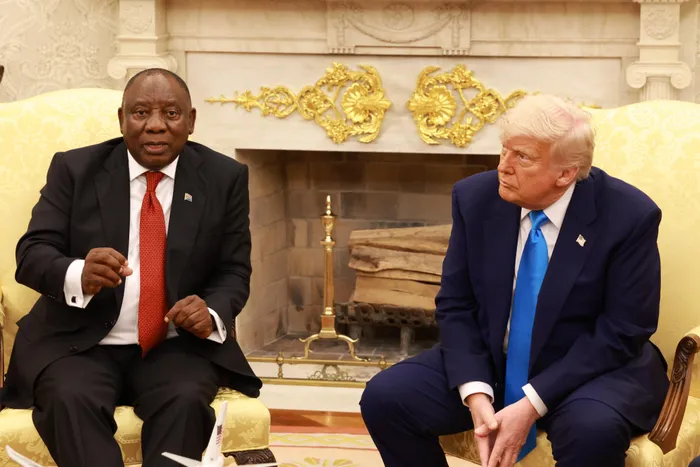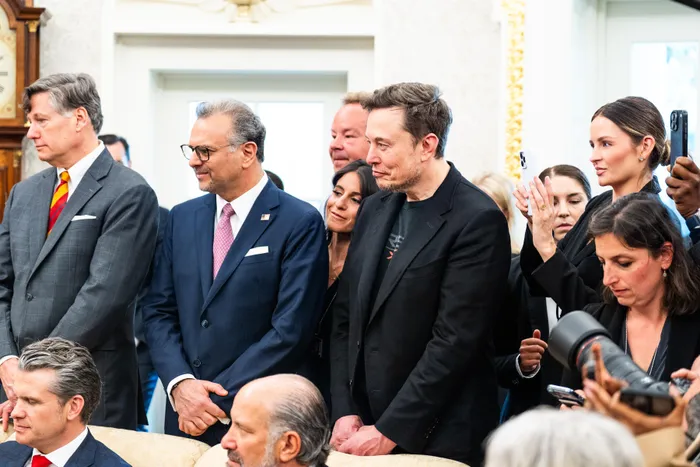
South African President Cyril Ramaphosa sets the record straight on the exaggerated claims of white genocide taking place in the country when he met with US President Donald Trump on Wednesday.
Image: GCIS
President Donald Trump pressed South African President Cyril Ramaphosa to protect White Afrikaner farmers from violent attacks in an extraordinary Oval Office confrontation Wednesday in which it fell to others to remind Trump of the nation’s long-standing epidemic of violence against both White and Black people.
Trump amplified false claims that White Afrikaners have been victims of a genocide, even showing video of crosses and earthen mounds that he said represented more than 1,000 grave sites of murdered farmers. The mounds were in fact part of a protest against the violence, not actual graves.
Trump also made no mention of South Africa’s violent and discriminatory history of White rule before the end of apartheid.
Ramaphosa stared straight ahead during the exchange, occasionally moving in his seat and looking over at Trump, who wouldn’t make eye contact as a clip played of crowds repeatedly shouting, “Kill the Boers,” a reference to White farmers descended from colonists who built and led the nation’s brutal apartheid regime.
While Ramaphosa and several of his deputies agreed with Trump that curbing violence should be a priority, they also noted that it is a problem across all of South Africa, not just in rural areas and certainly not just against White people. And they rejected Trump’s claim that the government is responsible for the murder of White farmers, a group he has characterized as victims of violence and of discriminatory laws.
The remarkable exchange was broadcast live around the world and showcased Trump’s selective, and racially polarizing, view of entrenched challenges in a country that endured nearly half a century of state-sanctioned segregation. The stance also reflected a theme of his second term: that efforts at equity have tilted the world against White people, denying them opportunities in favor of unfairly elevating minorities.

Tesla CEO Elon Musk listens during a meeting with South Africa presidents Cyril Ramaphosa and President Donald Trump in the Oval Office Wednesday.
Image: Demetrius Freeman/The Washington Post
The Oval Office meeting had been billed as a chance to reset the trade relationship between the two countries after Trump’s tariffs, and came as tensions escalated over the president’s interest in Afrikaners. Trump in recent months expelled South Africa’s ambassador to the United States and slashed aid to the country over the issue, which has long been a focus of Elon Musk, a South African-born senior adviser to Trump who was in the room Wednesday.
After watching the video, South Africa’s president asked: “Have they told you where that is? Mr. President? I’d like to know where that is. Because this I’ve never seen.”
“It’s in South Africa,” Trump responded.
The video focuses on Julius Malema, leader of the Economic Freedom Fighters, a party that advocates giving White-owned land to Black people. That clip was seized on by Musk, who tweeted in 2023, “They are openly pushing for genocide of white people in South Africa.” Ramaphosa’s African National Congress party, a former liberation movement, distanced itself from the song featured in the clip in 2012 - the same year it expelled Malema from the party.
The meeting began with a lighter mood, and Trump warmly greeted Ramaphosa outside the West Wing before they moved into the Oval Office. Still, Trump hinted at potential problems ahead: “He is a man who is certainly, in some circles, really respected. Other circles, a little bit less respected. Like all of us, in all fairness,” he said, making clear that the meeting was coming at Ramaphosa’s request.
Ramaphosa noted in his opening comments that Trump requested that he bring along some South African sporting legends, although Trump seemed disappointed that Ramaphosa didn’t bring Gary Player, the retired South African golfer.
“I spoke to him,” said Ramaphosa, who also gifted Trump a book on South African golf courses. “He said, ‘Look, I’m getting on in my years.’ But he wishes us luck in this discussion with you.”
Trump soon turned toward more pointed criticism, and the scene turned into one matched only by the one months ago when Ukrainian President Volodymyr Zelensky came to the White House and was criticized by Trump and Vice President JD Vance.
“We’ve had tremendous complaints about Africa, about other countries, too, from people,” Trump said Wednesday, looking at Ramaphosa next to him. “They say there’s a lot of bad things going on in Africa. And that’s what we’re going to be discussing today.”
The U.S. recently granted refugee status to White South Africans under a humanitarian designation meant for people fleeing war or persecution that the Trump administration has suspended for other groups worldwide, and welcomed roughly 50 Afrikaners to the country this month.
Trump held up news articles in the Oval Office that he suggested were validation of his claims of genocide, but he later said he hadn’t decided whether what is occurring in South Africa should be declared as such.
“I haven’t made up my mind. I hate to see it from the standpoint of South Africa,” he said. “I’m trying to save lives, no matter where.”
South Africa does not release crime statistics based on race, which makes it difficult to identify killings of White farmers. Official police data shows 12 people were killed on farms between October and December 2024 - a period during which 6,953 people were murdered in the country. South Africa has one of the highest homicide rates in the world, the data shows, and has been plagued by violent crime for decades.
In the Oval Office, John Steenhuisen, the minister of agriculture in South Africa, who Ramaphosa pointed out is White, conceded that there are problems that South Africa needs to address when it comes to the safety of farmers.
“I would say we have a rural safety problem in South Africa,” he said during the tense meeting in the Oval Office. “I don’t think anyone wants to candy-coat that. And it requires a lot of effort to get on top of it.”
He said more policing is required, as well as a different strategy to address the problems. “But certainly the majority of South Africans, commercial and smaller farmers really do want to stay in South Africa and make it work,” he added.
Trump grew irritated during the meeting when a reporter asked about his willingness to accept a $400 million airplane from Qatar, which he wants to retrofit for use as a new Air Force One.
“I’m sorry, I don’t have a plane to give you,” Ramaphosa said, triggering some laughter and temporarily breaking the tension.
“I wish you did,” Trump said. “I would take it.”
His focus on White Afrikaners has intensified in recent months after the enactment of a law that allows the country’s government, in rare cases, to expropriate land without compensation. The nation’s leaders have described it as a tool to help unwind the legacy of apartheid, but Trump has said it discriminates against White farmers - a contention the South African government has denied.
Ramaphosa has repeatedly challenged Trump’s portrayal of the country’s treatment of White people, which a 2017 audit found make up 7 percent of the population of South Africa but own three-quarters of the country’s land in an enduring vestige of state-sanctioned segregation.
While Ramaphosa in public comments leading up to the meeting said he hoped to “consolidate good relations between our two countries,” Trump’s criticism complicates efforts to recalibrate the relationship.
South Africa faces economic hurdles connected to Trump’s tariff policies. The U.S. is one of South Africa’s leading trade partners - behind only China. The U.S. imported $14.7 billion worth of goods from the country last year, up 4.9 percent from 2023, according to the U.S. trade representative.
As Africa’s largest economy, South Africa has been roiled by global financial uncertainty caused by Trump’s tariffs. Wednesday’s meeting came at a time of low growth and high unemployment in South Africa, which is keen to attract U.S. investment and benefit from a trade pact under the U.S. African Growth and Opportunity Act (AGOA), which expires in September and provides eligible sub-Saharan African countries with duty-free access to U.S. markets.
Barney Mthombothi, a columnist for the Sunday Times, former editor of the Financial Mail and the Sunday Tribune, and former head of the South African Broadcasting Corp., said before the meeting that many South Africans were wary of it.
“A lot of people think this is a trap, a setup,” Mthombothi said. “If Trump was interested in [knowing] what was happening in this country, how can he take action and then listen afterward?”
Refugees seeking asylum in the U.S. without the benefit of a presidential push can languish for years, and some critics have questioned the administration’s decision to welcome Afrikaners as refugees under a humanitarian designation meant to shield people fleeing persecution when it has denied this help to many non-White victims of violence.
“The whole idea that White South Africans are being oppressed is so scandalous, it’s offensive to Black people who have been oppressed for centuries,” Mthombothi said.
Just before 3 p.m. Wednesday, Ramaphosa left the White House through the same door he had entered three hours before.
He told reporters the meetings had gone “very well” and added that he thought Trump heard him. “Yes he did; it went very well,” he said.
Among the last to leave with Ramaphosa were two golfers who had attracted Trump’s attention, Ernie Els and Retief Goosen.
